
When contacting us by e-mail, correspondents are asked to include their name and full postal address and, when providing information, to quote exact book and magazine sources. The word ‘chess’ needs to appear in the subject-line or in the message itself.
| First column | << previous | Archives [35] | next >> | Current column |

This picture appeared on page 52 of the March 1924 American Chess Bulletin with the caption ‘Capablanca’s Bungalow Near Havana’.
C.N.s 1960 and 2035 (see pages 206-209 of Kings, Commoners and Knaves) presented a range of opinions on what constitutes a combination and, in particular, on whether a sacrifice is mandatory. In the present item we approach the issue from another direction: when was ‘combination’ first used as a chess term, and in which language?
As regards English, the Oxford English Dictionary (which has the definition ‘an ingenious sequence of moves in chess’) offers as its earliest citation ‘Mr Blackburne is not apt to lag when the opportunity for a fine combination presents itself’ on page 469 of The Field, 15 May 1875. However, we would mention that in the London Era, 1858 J. Löwenthal wrote as follows concerning 21 Rf3 in Morphy v Baucher, Paris, 1858:
‘The commencement of a brilliant combination, worthy of the immortal Labourdonnais, with board and men before him, and marvellous when we consider that Mr Morphy was playing blindfolded, and conducting at the same time seven other difficult games.’
Information on the exact issue and page number of Era would be appreciated, since we have only a reprint of the column in an 1858 US newspaper.
‘Combination’ was also used by Löwenthal when annotating the Morphy v Baucher game on page 185 of his book Morphy’s Games of Chess (London, 1860), but how much further back can the term be traced, in any language?
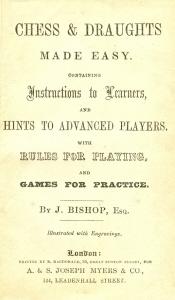
Some more information can, at last, be provided on Chess & Draughts Made Easy by J. Bishop, a book from the mid-nineteenth century which we possess but have never seen mentioned in any chess catalogue or bibliography (see page 366 of A Chess Omnibus and page 269 of Chess Facts and Fables).
Michael Clapham (Ipswich, England) reports that he has recently inspected a copy of the Bishop work at the British Library in London:
‘The book is undated, but the British Library dates it as circa 1855. It is a delightful little work bound in blue cloth-covered boards, blind-stamped and with the title on the front cover in gilt. All edges are gilt and the book has lemon glazed endpapers.
I also examined Draughts and Chess for the Millions! – The whole art of chess and draughts published by J. Cleave (London, 1844?), which has chess on pages 3-21 and draughts on pages 21-23. Large parts of the Bishop book up to page 16 are very similar to Draughts and Chess for the Millions. The “Advice to Beginners” from page 16 onwards is largely taken from Hoyle’s Rules for Chess (included in many editions of Hoyle’s Games), which are also in Draughts and Chess for the Millions. There the chess section of the “Millions” book ends, whereas the Bishop work continues with a selection of openings and games.
It is, indeed, curious that Bishop’s book is apparently not mentioned in any chess bibliography or catalogue. I have also ascertained that the book is not recorded in the standard draughts bibliography, The Literature of Checkers by William T. Call (New York, 1908).’
Although it is nearly five years since we raised the subject of the Bishop book (in C.N. 2710), this is the first time that the existence of another copy has been notified to us. A curiosity is that whereas the cover of the edition inspected by Mr Clapham is blue, ours is red.
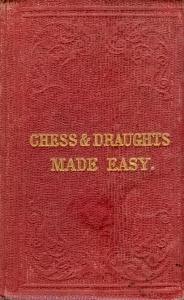
Javier Asturiano Molina (Murcia, Spain) quotes from pages 187-188 of Think Like a Grandmaster by A. Kotov (London, 1971):
‘Adjourned positions sometimes occur in which it is hard to forecast the result. You come home thinking you are going to win. You examine it and find it is nothing like as simple as you thought, and are taken aback. In such cases we often say jokingly to each other, “Let us apply the ‘Lilienthal principle’”.
The point is that this experienced grandmaster and trainer always starts analysing a position by asking himself if he can draw it, and only when he finds that he has at least a draw does he start looking for a way to win it. Try this method and you will find that your analysis becomes more exact and not so long-winded.’
The Villa Fabbricotti (Livorno, Italy) informs us that it holds a copy of the book Vers l’Exil (Paris, 1939) and that both the front cover and the title page name the author as Margareth (not Margaret) Sothern. The original language of the novel is not specified.
We have acquired a copy of the English translation, by Maisie Ward, Chosen Races (New York, 1939). The author’s forename is given as Margaret on the title page and the dust-jacket, and the latter summarizes the plot as follows:
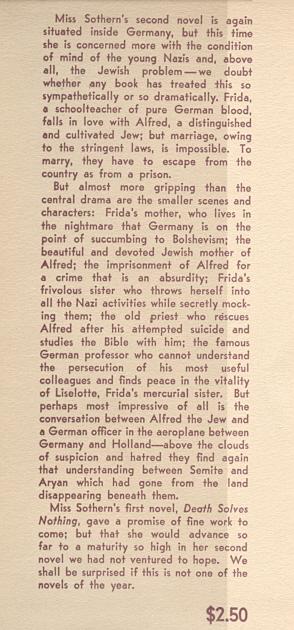
In short, if the Portuguese news report mentioned in C.N. 4991 is correct, Alekhine had beside him at the time of his death an anti-Nazi novel about Rassenschande.
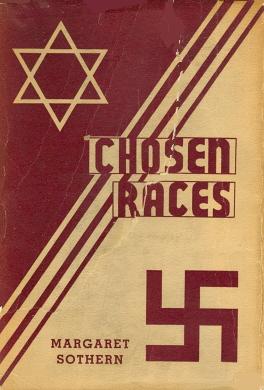
From Robert John McCrary (Columbia, SC, USA):
‘Concerning early uses of “combination”, I found several in the Chess Player’s Chronicle, 1854. Pages 55-57 use the word repeatedly. Page 55, for instance, states: “... he scarcely makes a single combination beyond the reach of a third-rate amateur”. Page 189 says that Harrwitz will never be among the “lords of combination”. An article on pages 323-325 discusses styles and characteristics of some strong players, using the term “combination”.
However, in none of these cases does “combination” have a meaning that can be clearly judged from the context, leading me to suppose that the term initially referred in a general sense to calculation skills, without necessarily meaning a specific set of calculated variations.’
C.N.s 3079 and 3251 (see pages 326-327 of Chess Facts and Fables) discussed a quote attributed to Teichmann, and now we note that Fred Reinfeld also gave it on page 129 of The Chess Masters on Winning Chess (New York, 1960):
‘It took Nimzowitsch 20 years of tireless preaching to achieve acceptance. So great a master as Teichmann commented dourly that “in the first place there is no Hypermodern School, and in the second place Nimzowitsch is its founder”. This was a more or less polite way of saying that Nimzowitsch was crazy.’
That last remark of Reinfeld’s seems far-fetched, and it is unclear why he affirmed that Teichmann made the remark ‘dourly’.
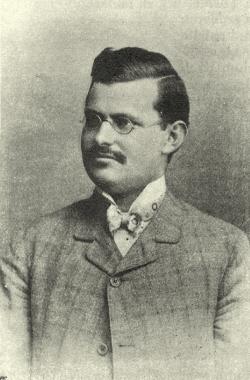
Aron Nimzowitsch
Reinfeld on Nimzowitsch can be a strange spectacle. For example, on that same page he wrote: ‘By the time Nimzowitsch was 20, he had perfected his system.’ In his revised edition of Nimzowitsch’s My System (Philadelphia, 1947) Reinfeld wrote (page xxi) that ‘by 1906, when he was only 20, Nimzowitsch had definitely become a master of the very first rank’.
Eric Fisher (Hull, England) has shown us a painting by Samuel Boden (1826-1882) which he acquired at an auction in 2002:
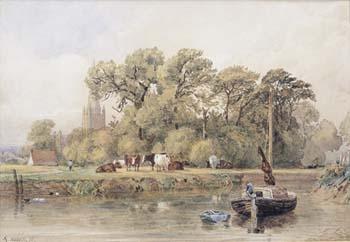
The catalogue described it as follows: ‘Norwich from the River, water colour, signed lower left. 25.5 x 37cm. Provenance: Ex Bonhams, 15 March 1980.’
Our correspondent is seeking further information about Boden’s art. On pages 167-168 of the Chess Monthly, February 1882 an obituary referred in general terms to Boden as a landscape painter and art critic, also describing him as ‘one of the best chessplayers England ever produced’. Page 31 of the Chess Player’s Chronicle, 18 January 1882 stated that ‘on coming into some property, through the death of a relative, he entirely devoted himself to art’.

Samuel Standidge Boden (Chess Life-Pictures by G.A. MacDonnell, page 35)
A feature on page 104 of Fred Reinfeld’s The Treasury of Chess Lore (New York, 1951) entitled ‘Morphy’s Estimate of Staunton’ was taken from page 410 of the September 1891 BCM, but the latter offered no source. For that, and a more extensive version, we turn to page 155 of Paul Morphy The Pride and Sorrow of Chess by David Lawson (New York, 1976):
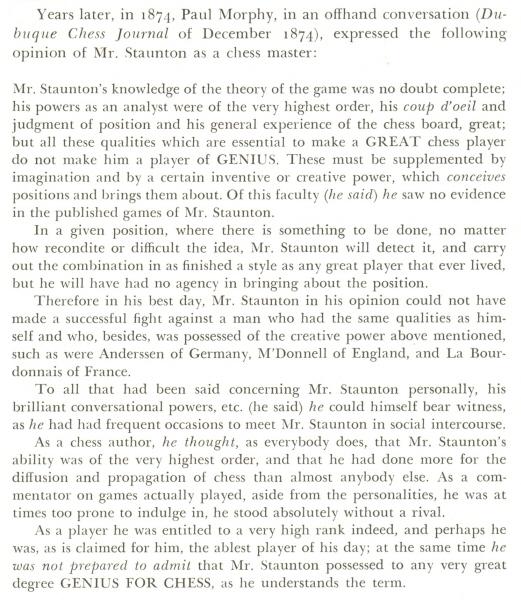
Is a reader able to supply the item as it appeared in the Dubuque Chess Journal or in any other source during Morphy’s lifetime? We should like to know the exact context and circumstances of this ‘offhand conversation’.
We recall the following note by Staunton on page 88 of his London, 1851 tournament book, with respect to the first game between Williams and Muclow:
‘In some respects these players were well paired, not for equality of force, indeed, Mr Williams being by far the stronger, but because each, in his degree, exhibits the same want of depth and inventive power in his combinations, and the same tiresome prolixity in manoeuvring his men. It need hardly be said that the games, from first to last, are remarkable only for their unvarying and unexampled dulness.’
As listed under ‘Memory’ in the Factfinder, a number of C.N. items have discussed reports of memory exploits. Now Christian Sánchez (Rosario, Argentina) draws attention to an extract from an article entitled ‘The Psychology of Chess’ by H. Rogosin on pages 21-22 of Chess Review, January 1939:
‘Blackburne, the famous Englishman, in 1899 was quoted as recalling any number of games played in 1862. In the present day, Alekhine, world’s champion, is supposed to be able to recall every game of note of the last 30 years, with all their moves.’

Alexander Alekhine
Regarding Alekhine, we add two comments by Capablanca:
‘Consider the fact that the great masters of truly superior class, like Alekhine and Bogoljubow, young men, know every opening variation that has been frequently used by other masters; that Alekhine, for instance, who is only 33, knows every game played in any tournament or match in the past 25 years ...’
Source: Revista Bimestre Cubana, March-April 1926.
‘He has what is probably the most marvelous chess memory that ever existed. It is said that he knows by heart every game played in any tournament by either a first-class club player or a master during the last 25 or 30 years. He certainly knows by heart all of the games ever played by any of the first-class masters.’
Source: New York Times, 19 February 1927, page 10.
As regards his own memory, Capablanca wrote:
‘... as I have grown older – in fact since I became a first-class chessplayer – I have always tried to forget everything which I have not considered essential to remember, and I have succeeded so well in my training that I now have difficulty in remembering things in general. It so happens, now, that while there are several experts who remember every serious game I have played in the last 22 years, I can hardly remember a single one of them. A game played today I may hazily keep in my head for a few weeks, but after that it is gone forever. No doubt my present poor memory is a cultivated one. I have been influenced to adopt this system in order to avoid loss of sleep after a hard struggle at night. Thus I can go to sleep right after a game, whether I win or lose, and one hour after a long, strenuous, simultaneous séance against any number of opponents I may be found peacefully sleeping in my bed.’
Source: The English Review, November 1922, pages 459-462.
The full context of these quotes is provided in our book on Capablanca (pages 130, 156-157 and 121-122 respectively).
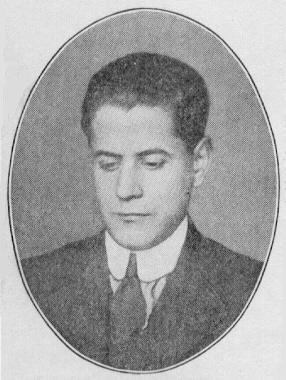
José Raúl Capablanca
Information is sought on a game purportedly won by Capablanca at queen’s knight odds in 1919 against an unnamed player: 1 e4 e5 2 f4 exf4 3 Nf3 g5 4 Bc4 Bg7 5 O-O h6 6 g3 g4 7 Nh4 f3 8 Nxf3 gxf3 9 Bxf7+ Kxf7 10 Qxf3+ Nf6 11 e5 Rf8 12 exf6 Bxf6 13 d4 Kg7 14 Qh5 Bg5 15 Rxf8 Kxf8 16 Bxg5 Qxg5 17 Rf1+ Ke7 18 Qf7+ Kd6 19 Rf6+ Qxf6 20 Qxf6+ Kd5 21 Qe5+ Kc6 22 Qc5 mate.
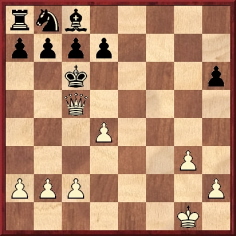
The game-score was given on page 658 of 500 Master Games of Chess by S. Tartakower and J. du Mont (London, 1952).
Jan Kalendovský (Brno, Czech Republic) sends the following curiosity, dated 1900:
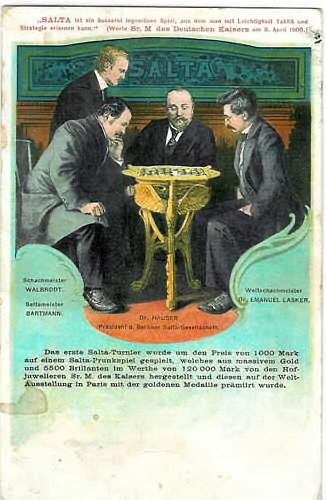
[Afterword: On 18 June 2010 Mr Ralf Gering (Brohltal, Germany) informed us that he is the owner of the above card, which he posted at the BoardGameGeek webpage.]
Further to the furniture-destruction story discussed in Chess with Violence, Mark Nieuweboer (Moengo, Surinam) refers to an article on Spielmann by Hans-Wilhelm Fink on pages 111-149 of Rudolf Spielmann Portrait des [eines] Schachmeisters in Texten und Partien by Michael Ehn (Koblenz, 1996). Pages 127-128 quote most of what Hans Kmoch wrote on pages 61-62 of his book Die Kunst der Bauernführung (Berlin-Frohnau, 1956). The relevant part of Kmoch’s book is the final paragraph of that section:

The passage in question (over 60 lines) is absent from the English edition of Kmoch’s book, Pawn Power in Chess (New York, 1959). Our correspondent asks whether Kmoch was present during the Carlsbad, 1923 tournament.
We add that Michael Ehn’s book on Spielmann is admirably researched.
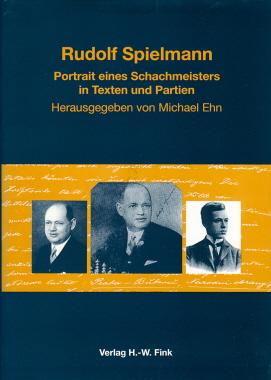
We are still seeking information about ‘Edward Young’ (see page 327 of Kings, Commoners and Knaves). Books and articles appeared under his name, but Douglas A. Betts’ Bibliography stated that ‘Edward Young’ was a pseudonym for Fred Reinfeld.
The first appearance of the name that we have found is on page 114 of Chess Review, April 1955, at the start of a two-page article:

The two volumes below have the same contents and were published in 1960 by, respectively, Arco Publications, London and Castle Books, USA:
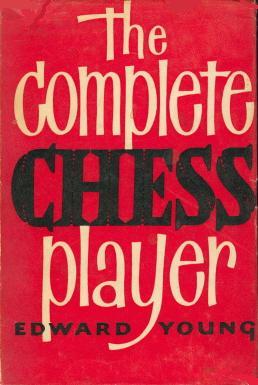

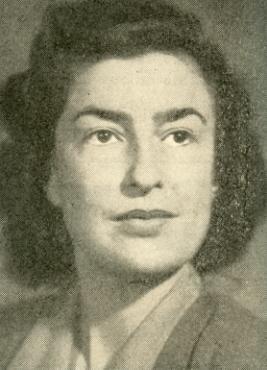
‘The December Newsflash quotes some highly interesting remarks from various learned sources on the alleged inferiority of women chessplayers, who it appears are subject to “biologically programmed ‘interrupts’ which prevent them from concentrating on an intellectual task effectively”. The Editor, with superhuman courage, has actually invited readers’ comment.
The BM considers himself admirably qualified to educate the chess public on this subject, having spent a whole afternoon at the BCF Congress last August watching the grandmasters and grandmistresses of tomorrow, i.e. the “Under Elevens”. There were 16 boards in action, manned mainly by the male sex, but with a large sprinkling of “diminutive damsels”. For chessboard deportment the BM was forced to award the ladies the palm. They sat upright – and indeed their wide-awake appearance was such that some of the “slouching seniors” across the gangway did not benefit by the comparison. In matters of tournament ritual and etiquette they clearly “knew their onions”, and though the rate of play was fast and occasionally hectic, there was “no clock vandalism”, and they recorded their moves with the precision of old professionals. One very small maiden, it is true, did discover that she had missed one out and proceeded some distance down her opponent’s lane in the score-sheet motorway, but she then put up her hand to summon the Controller, a kindly man with a beard who sorted things out in no time. Only four boards started with P-K4 for White and Black – there was what Morphy called “that pernicious fondness” for the Sicilian, but both sexes had got hold of the need for development, and one young lady had cleared her back yard and castled long by the ninth move. Middle-game observation was keen-eyed, and there were few blunders. It was in the endgame that the real weakness showed, and here the greater staying power of the males, and the “biologically programmed what’s-its-name” of the fair ones began to come out. Two hours’ tournament chess is hard graft for a girl of nine on a hot day – the attention begins to wander as the pieces thin out, and there is a tendency to give check or to swap rooks just to get the move over, irrespective of “open file” consequences. The longest game of the day was between a lady who could have only just seen nine Summers and a solid youth some months older. During the middle game “the female proved more deadly than the male” and emerged with king, rook and three pawns against “Solidarity’s” mere king and two pawns. But alas, they were passed pawns well up the board, and the unhappy maiden, instead of bringing her king across to face them, went on checking with her rook until it finally went for a Burton, and “Solidarity” emerged with king and queen against king and three poor isolated pawns. Even then, apparently more through caution than sadism, he deliberately mopped up the three harmless stragglers and refrained from embarking on the final attack until “all was safely gathered in”.
While these titanic struggles were in progress, a large muster of parents relaxed in the Tea Lounge. One lady, apparently discussing her daughter’s defeat on the previous day, uttered one of the most profound truths ever heard at a Chess Congress. “It seems”, she observed mysteriously, “that there are some positions you can’t get out of”.’
William J. Stewart (Glasgow, Scotland) is seeking information about Captain Smith, who lost a well-known game to Philidor in London in 1790.
The ‘notices biographiques’ in the authoritative book Philidor musicien et joueur d’échecs (Paris, 1995) contain merely the following (page 229):
‘Smith, le Captain. Joueur d’Échecs. On connaît surtout la partie qu’il joua contre Philidor le 13 mars 1790 et qui a été plusieurs fois commentée.’
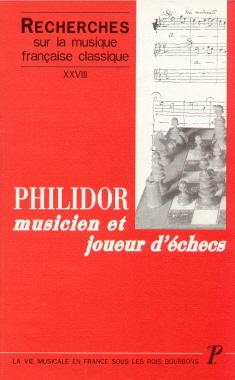
Mark McCullagh (Belfast, Northern Ireland) draws attention to the following passages in The Incomparable Game of Chess ‘Translated from the Italian of Dr Ercole Dal Rio by J.S. Bingham, Esq.’ (London, 1820):
Pages 33-34:
‘The method which is necessary to undertake and execute the attack, consists in determining an advantage, which is hoped to be obtained by the nature and combination of the game, or by less dexterity on the part of the Adversary ...’
Page 36:
Page 302:
Our correspondent mentions that the entire book is available online, together with a Greco work.
Avital Pilpel (Haifa, Israel) asks what facts are available concerning the well-known story about Nimzowitsch lamenting ‘Why must I lose to this idiot?’.
It was related by Hans Kmoch in his article on Nimzowitsch available online at the Chess Café:
‘On another occasion, in Berlin, having missed the first prize by losing to Sämisch, Nimzowitsch got up on a table and shouted, “Why must I lose to this idiot?” This story was told to me by the idiot himself.’
An article by Hans Kmoch and Fred Reinfeld entitled ‘Unconventional Surrender’ on page 55 of the February 1950 Chess Review specified that the occasion was a rapid transit tournament:
‘A man mounting a table, however, and yelling at the top of his voice, “Why must I lose to this idiot!” (“Gegen diesen Idioten muss ich verlieren!”) would be following the example of Nimzowitsch, who thus vented his rage – after losing in the last round of a great rapid transit tournament in Berlin and so missing first prize.’
The tournament in question has yet to be identified.
From John Roycroft (London):
‘Do any photographs or good drawings exist, possibly in contemporary Russian sources, of the chessmen used in the 1896-97 world title match in Moscow between Lasker and Steinitz? Moreover, are there any illustrations of the match sponsors and the “playing committee”? My particular interest is in establishing whether or not reports are correct that a chess set was made in Russia to the order of Steinitz.’
The Factfinder lists a number of masters’ announcements of their intended retirement from chess, and an addition comes now from Christian Sánchez (Rosario, Argentina):
‘Page 282 of Chess Review, December 1938, quotes an interview given by Reuben Fine to Savielly Tartakower that had appeared in De Telegraaf. One passage reads:
“Earlier this year he [Fine] had decided to give up chess as a profession and complete his studies in mathematics. Last May he had asked the AVRO committee to release him, but was forced to live up to his contractual agreement to play.”’
Michael McDowell (Westcliff-on-sea, England) refers to C.N.s 2755, 2766 and 2772 (see pages 59-60 of A Chess Omnibus), which discussed a composition by H.F.L. Meyer:
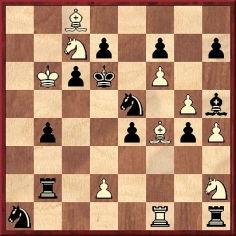
Mate in eight
It may be recalled that on pages 274-275 of his book A Complete Guide to the Game of Chess (London, 1882) Meyer offered prizes to readers able to solve the problem. The intended solution was 1 g6 hxg6 2 d4 exd3 3 Ba6 Rc2 4 Rf3 gxf3 5 Ng4 Bxg4 6 Bc4 Rxc4
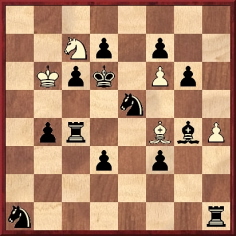
7 Bh6, followed by 8 Bf8 mate. However, a computer-check indicated that after 1 g6 Black can prevent the mate with 1...Ra2, followed (in most variations) by 2...Ra5, and Martin Hoffmann (Zurich) therefore proposed the addition of a white pawn at b3 and a black pawn at a6 in the initial position.
Now Mr McDowell quotes from page 131 of The Problemist, May 1931, which reported on a lecture entitled ‘Wager Problems’ given by John Keeble on 30 January 1931. Keeble presented Meyer’s problem and stated:
‘The composer offered a prize of £3 for the first complete solution of this. The late J.A. Miles sent the first correct paper, but H.F.L.M. declined to pay up because the solution was not written out in his “International” K.L.M.N.O.P. notation. Moreover he refused to pay any other solver because he was not the first! A piece of smart practice fortunately without any parallel in British chess problem history.’
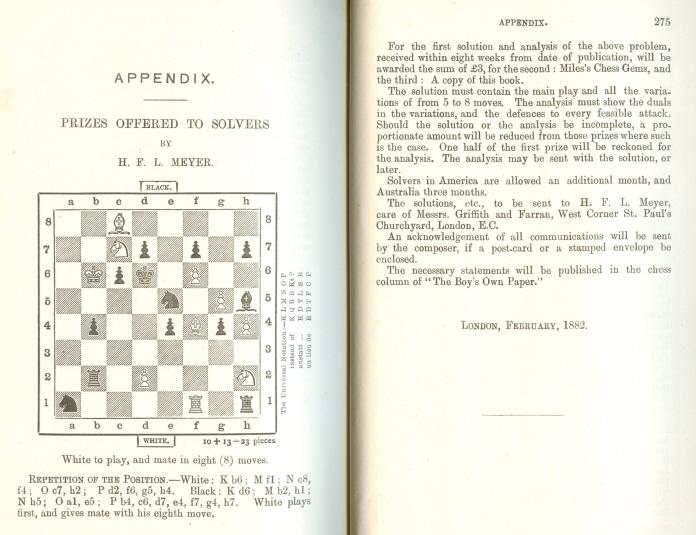
Pages 274-275 of A Complete Guide to the Game of Chess by H.F.L. Meyer.
Regarding Meyer’s notation, see C.N. 4589.
Pages 252-253 of Chess Facts and Fables discussed the story that Adolf Roegner published a ‘book’ which was blank except for instructions to spectators to keep quiet. C.N. 3356 commented:
‘We also note that the chess library in The Hague holds (item L/N 44) a copy of Roegner’s 40-page “Haupt-Katalog” dated 1885 ... It remains to be ascertained whether the catalogue mentions “Spielregeln für Nichtmitspieler”.’
Now Joost van Winsen (Silvolde, the Netherlands) has kindly supplied a copy of the relevant part of the catalogue (page 36):
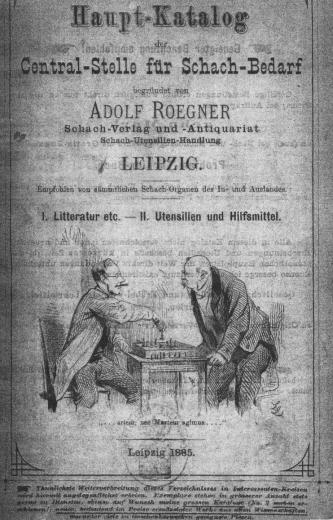
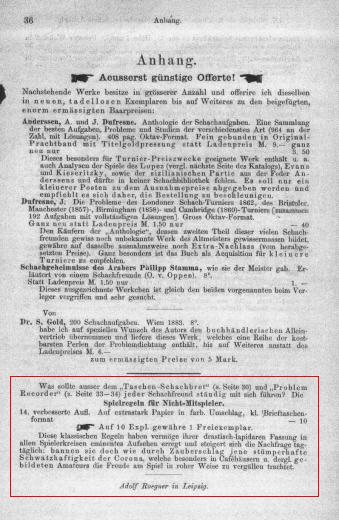
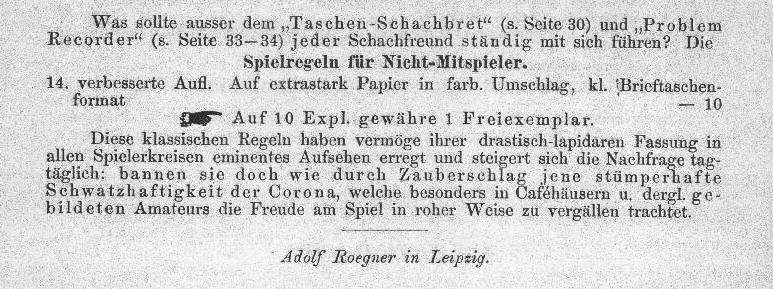
From page 123 of The Teenage Chess Book by Reuben Fine (New York, 1965):
‘Our last scene is entitled Hail the Unknown. It is from a game Adams-Torre, New Orleans, 1925 [sic]. Adams, the winner, was never heard of before and has never been heard from since. Yet his play here bears the unmistakable stamp of real creative genius.’
Fine’s remark about Adams’ obscurity is an exaggeration. For
instance, our extensive review of the evidence about the game in
C.N. 3472 mentioned that Adams was the subject of an article on
pages 110-111 of the May-June 1927 American Chess Bulletin.
The same issue (pages 97-99) had, eccentrically, a long article
by him on the Great Mississippi Flood of 1927.
When were doubts about the game’s authenticity first expressed in print? In particular, pre-1983 instances are sought, for it was in that year that C.N. 397 quoted from a book catalogue (‘Potpourri Eight’) issued by Dale Brandreth:
‘The world famous Adams-Torre game supposedly from New Orleans, 1920 is highly questionable. The first evident publication was in the American Chess Bulletin for 1925, page 157, with notes by Torre himself. But why would a game of such fantastic brilliance have not made the rounds years before? E.Z. Adams was largely responsible for bringing Torre to prominence, and the theory has been advanced by the noted chess writer David Hooper that Torre may have generously credited to Adams such a game which was partly actual play and partly analysis ...’
Whatever (circumstantial) evidence of a concoction may have been identified, it should be noted that both Torre and Adams (in 1925 and 1943 respectively) stated in print that they had indeed played the game.
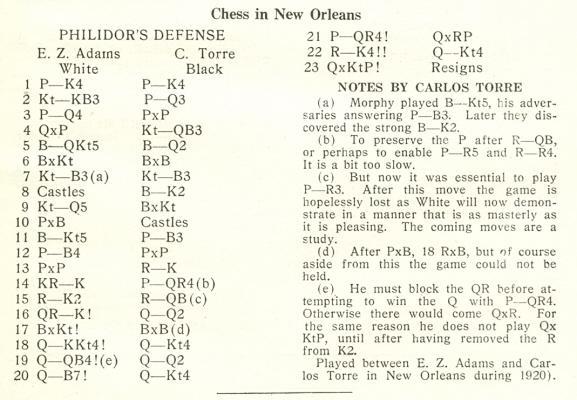
American Chess Bulletin, November 1925, page 157

Chess Review, May 1943, page 146
Page 260 of An illustrated Dictionary of Chess by Edward R. Brace (London, 1977) stated:
‘The greatest simultaneous display was undertaken by G.J. Martin in London in 1957. He played 142 opponents, defeating 130, drawing 11 and losing to one in less than four hours 40 minutes.’
Readers’ assistance in investigating this strange report will be appreciated. As regards the time specified, we quote for purposes of comparison (and more or less at random) two older performances: Marshall took seven hours 50 minutes against 155 opponents in Montreal on 7 January 1922, and Capablanca took seven hours against 103 players in Cleveland on 4-5 February 1922 (American Chess Bulletin, February 1922, pages 21-22).
An addition to our ‘Chess in the courts’ series comes from pages 78-79 of the International Chess Magazine, April 1888:
‘“Horwitz v Windust. 31 January, before Mr Justice Wills, Queen’s Bench Division. Mrs Horwitz, widow of the late B. Horwitz, sued Mr Charles Windust, a publican, proprietor of the Royal Mail public-house, Noble-street, City, to recover £45 under the following circumstances. It appeared that plaintiff was desirous of selling the copyright of her late husband’s work Chess Studies and End Games, with the stereotype plates belonging to it. She was introduced to defendant and, according to her case, he undertook to sell them for her. He succeeded in effecting a sale to Messrs Bell and Sons, publishers, for £75, and gave plaintiff £30, and she now claimed the balance, contending he acted as her agent. The defendant, on the other hand, said he was introduced to the plaintiff as one who would buy her book, and acted as principal throughout, buying the work absolutely for £30. In support of this he relied upon an agreement signed by him to the effect that he would give her £30, free from all expense, for the book. Defendant also said he paid £5 for the introduction to plaintiff, and had incurred some expense in finding a purchaser and in running down to Brighton to see plaintiff, who was visiting there. Mr Hextall appeared for the plaintiff, and Mr Lyon for the defendant. His Lordship came to the conclusion from the plaintff’s evidence, which was corroborated, that at the outset the defendant undertook to sell the book for the plaintiff, and a man could not change himself from an agent to a principal without giving the other side full knowledge of the change of circumstances, which in this case had not been given. The defendant evidently did not understand what the doctrines were upon which in a court of law or equity a question of this kind must turn, and he was sure his moral perceptions unaided would scarcely lead him in that direction. He must therefore give judgment for the plaintiff for £45. Mr Lyon pointed out that the defendant had been put to some expense. His Lordship said he would enter the judgment for £40 on that ground.” – Liverpool Courrier.’
Our latest feature article is a
chronological catalogue of court cases involving chess.

This is Chantal Chaudé de Silans. The photograph was published on page 50 of Chess World, 1 March 1950.
Chris Ravilious (Eastbourne, England) draws attention to two items in D.J. Morgan’s Quotes and Queries column in the BCM. On page 225 of the August 1968 issue Stewart Reuben contributed information on the ‘British Simultaneous Record’ in the 1950s: ‘G.J. Martin at Ilford, played 141: +125 =15 –1. This is the official record, says Mr Reuben.’ In the December 1968 BCM, page 385, D.J. Morgan published a follow-up item:
‘Writing from New Haven, Connecticut, G.J. Martin, with reference to S. Reuben’s figures given in our No. 1,883, gives these amended figures: played 142, won 130, drawn 11, lost 1. Mr Martin gave his display (“I seem to think in March 1957”) in aid of the British Universities’ Chess Team fund.’
From the June 1913 American Chess Bulletin, page 140:
‘Charles Henry Meltzer, writing in the May Cosmopolitan of Maurice Leblanc, the creator of the fictional character, Arsène Lupin, says that Monsieur Leblanc, when asked from whence he received the motif for the deeds of this famous criminal, replied:
“I have read Edgar Allan Poe and studied Balzac. All the romance of crime was suggested in Poe’s works. I don’t remember anything besides Poe and Balzac that could have helped me to work out my plots – unless my fondness for the game of chess was useful. Chess helps one to make plays. And why not novels?” – The Star of Hope.’
Since the meaning of ‘combination’ in nineteenth-century sources is often unclear, we are continuing to collect occurrences of the term. Robert John McCrary (Columbia, SC, USA) has found the following on page 313 of Chess and Chess-players by George Walker (London, 1850):
‘His combinations, instead of taking in half a dozen moves, involved 20 or 30.’
No further information about John Hart has yet come to light, but it may at least be mentioned that he was a friend of Julius du Mont, who dedicated to him his 1920 book on the Centre Game and Danish Gambit – Chess Openings Illustrated, volume two (London, 1920).
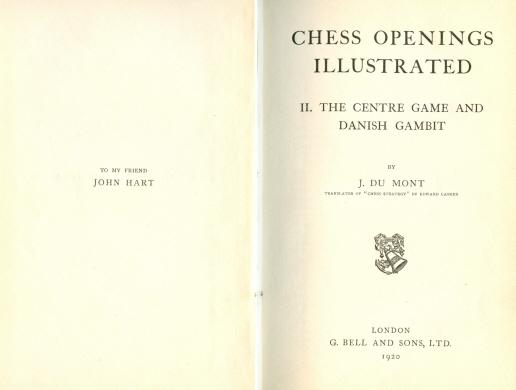
From Rod Edwards (Victoria, BC, Canada):
‘According to the Mechanics Institute website, the San Francisco Examiner of 8 July 1913 reported that a 31-game simultaneous display by Frank Marshall had been given in San Francisco and that:
“A feature of the exhibition was the participation of a nine-year-old devotee of Caissa, Miss Marie Silvius, at board No. 20, who secured a well played draw.”’
Dale Brandreth (Yorklyn, DE, USA) sends two games from pages 40 and 138 of the rare book Chess Players of New Orleans by Andrew Lockett (New Orleans, 1935):
Edwin
Ziegler
Adams
– Andrew Lockett
New Orleans, 1925
French Defence
1 e4 e6 2 d4 b6 3 f3 Bb7 4 Bd3 Qh4+ 5 g3 Qh5 6 Be3 Bd6 7 e5 Bxe5 8 dxe5 Qxe5 9 Kf2 Qxb2 10 Nd2 Nf6 11 h3 Nh5 12 Ne2 O-O 13 Bd4 Qa3 14 Nc4 Qe7 15 Qd2 d5 16 Ne5 c5 17 Be3 c4 18 Nxc4 dxc4 19 Bxc4 Qf6 20 Ng1 Qxa1 21 White resigns.
Morton – Edwin Ziegler Adams1 e4 e5 2 Nf3 Nc6 3 Bc4 Bc5 4 b4 Bxb4 5 c3 Ba5 6 d4 exd4 7 O-O Bb6 8 cxd4 d6 9 d5 Na5 10 Bb2 Nf6 11 Bd3 O-O 12 Nc3 Bg4 13 Kh1 Bd4 14 Qd2 Bb6 15 Ne2 c5 16 Ng3 c4 17 Bc2 Rc8 18 Nd4 c3 19 Bxc3 Nc4 20 Qc1 Ne5 21 Qb2 Qc7 22 Nb5 Qc5 23 Rac1 Nc4 24 Qb3 a6 25 Nd4 Ba5 26 Ndf5 Bxf5 27 Nxf5 Rc7 28 Bxf6 Qa3 29 Bxg7 Rfc8 30 Bf6 Qxb3 31 Bxb3 b5 32 Bxc4 resigns.
Dr Brandreth comments:
‘Leaving aside the Torre v Adams (French Defense) game published by Chernev which appeared in your feature article, these are, to the best of my knowledge, the only known true games of E.Z. Adams published anywhere, and they are both true patzer games.
As regards the famous “Adams v Torre” game, its first known publication came not from the winner but from the loser. This alone must arouse suspicion, since it was well known that Torre owed his start in New Orleans chess to Adams. The fact that Adams appeared to certify the game’s origins in 1943 does not mean too much. That was about 23 years later, Adams was in likely poor health (he died a year later), and who was he to dispute a game which any master would be proud to claim as his own when the loser himself publicized the game?
My view is that neither Torre nor Adams intended anything underhanded. Torre was later known to have said that who won the game was of no great importance and that it was the beauty of the idea that mattered. It is also a virtual certainty that in 1920 there was no tournament in New Orleans important enough to have Torre competing; in addition, it is extremely unlikely that any such tourney would have found Torre competing against players as weak as Adams. That essentially means that it had to be a skittles game. Most likely it was an analysis session where the interesting stem position came up and Torre pointed out the beautiful combination to Adams.
Above all, there is the simple, direct statement on page 287 of the fine book on Torre by Gabriel Velasco which is quoted in your feature article: Torre’s friends Alejandro Báez and Pedro Busto Undiano stated that the game was never played but was an idea of Torre’s after analyzing a skittles game.
An interesting sidelight is that there was another E. Adams in Torre’s career: Edward B. Adams, from New York State. A much stronger player than Edwin Ziegler Adams, he finished fourth in the New York State Championship at Rochester, NY in 1924. Torre won that tournament and defeated E.B. Adams in fine style.’
Calle Erlandsson (Lund, Sweden) draws attention to the subscription rates on page 2 of the first issue of George Koltanowski’s magazine The Chess World, 1 October 1932:
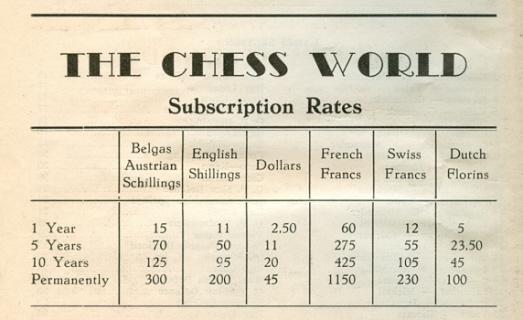
Given that the magazine ceased publication less than a year later, with a double number (10-11) dated July-August 1933, our correspondent wonders how many people subscribed for five years, ten years or permanently, and what happened to their money.
For our part, we should also like to know the outcome of Koltanowski’s ‘latest scheme’, as published on page 116 of the May 1942 CHESS:

The book referred to (‘In the dark’) was eventually published 13 years later as Adventures of a Chess Master, at $4. The 1986 algebraic edition took the title In the Dark.

The above photograph has been provided by Avital Pilpel (Haifa, Israel), who writes:
Did Fred Reinfeld, the author of The Immortal Games of Capablanca (New York, 1942), know much about the Cuban’s career? In C.N. 473 we listed defects in the chapter on Capablanca in Reinfeld’s book The Human Side of Chess (London, 1953). The list is reproduced below, and it should be noted that the page numbers in the US edition (New York, 1952) are different. Twenty-four years on from the publication of C.N. 473 there are a few points that we would present differently today, but it remains extraordinary that Reinfeld made so many factual errors in a single 24-page chapter.
Below is an excerpt from a letter to us dated 19 January 1977 from Irving Chernev (San Francisco, CA, USA):

| First column | << previous | Archives [35] | next >> | Current column |
Copyright 2007 Edward Winter. All rights reserved.